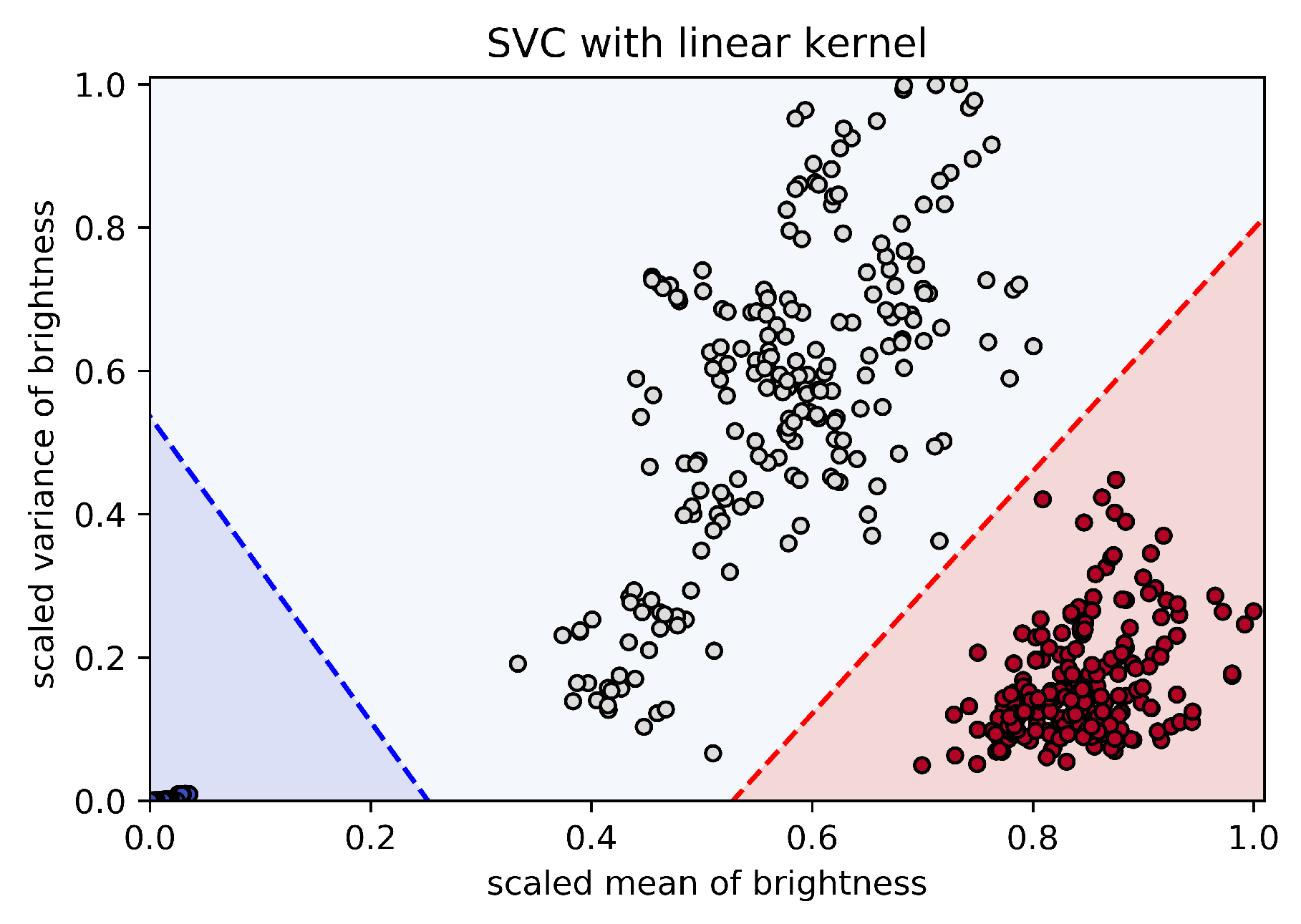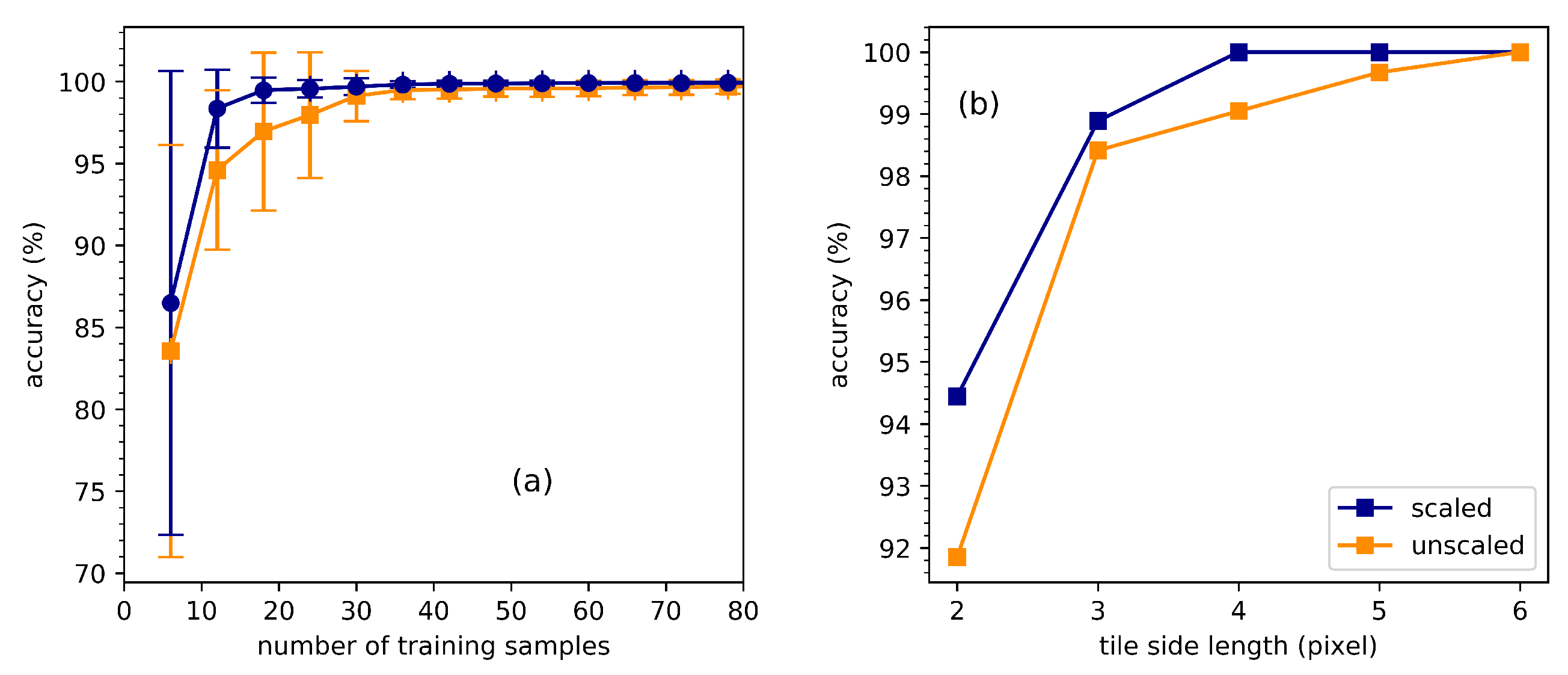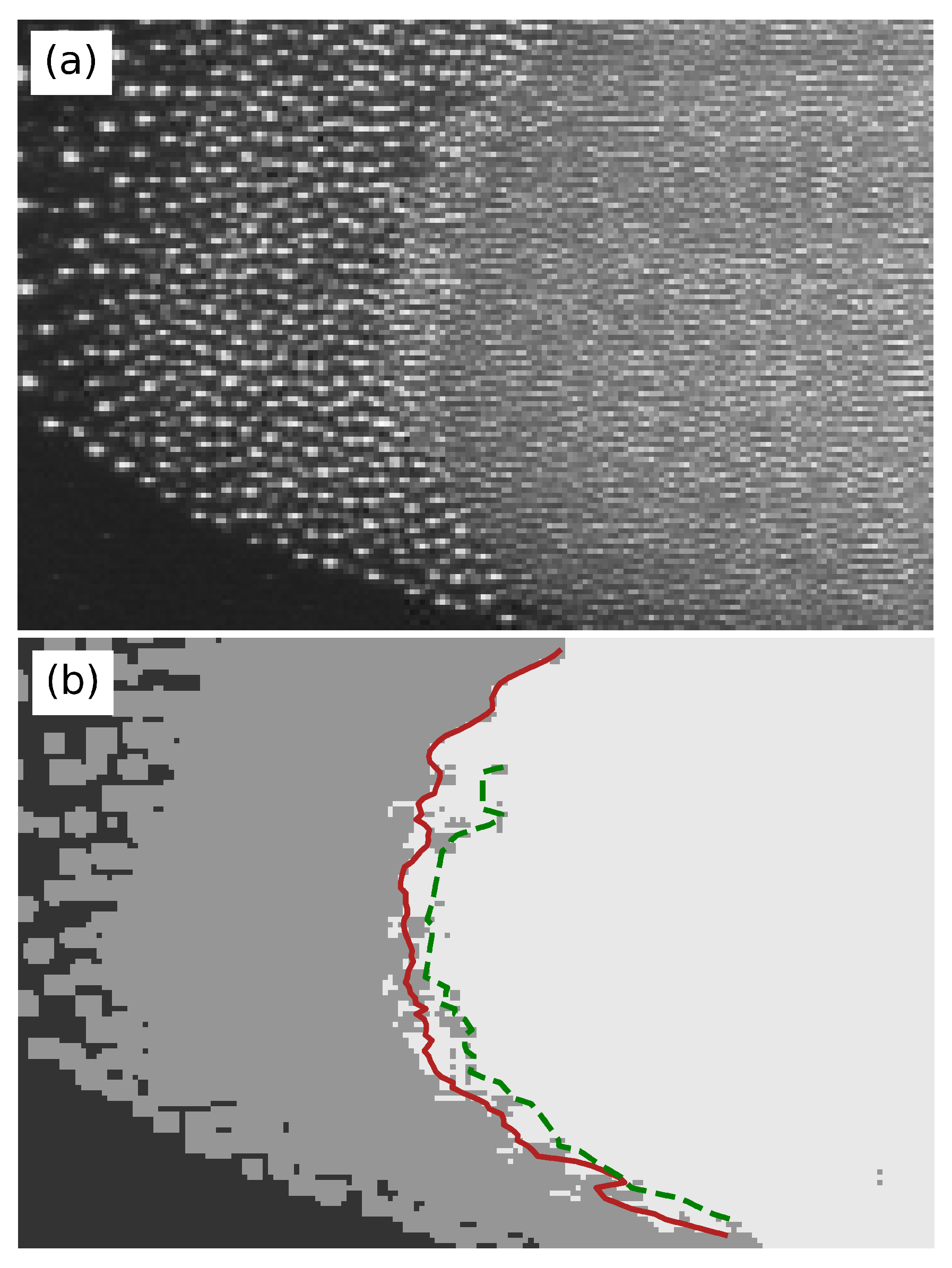Identification of the Interface in a Binary Complex Plasma Using Machine Learning
Abstract
Author Contributions
Funding
Acknowledgments
Conflicts of Interest
References
- Fortov, V.; Ivlev, A.; Khrapak, S.; Khrapak, A.; Morfill, G. Complex (dusty) plasmas: Current status, open issues, perspectives. Phys. Rep. 2005, 421, 1–103. [Google Scholar] [CrossRef]
- Morfill, G.E.; Ivlev, A.V. Complex plasmas: An interdisciplinary research field. Rev. Mod. Phys. 2009, 81, 1353–1404. [Google Scholar] [CrossRef]
- Chaudhuri, M.; Khrapak, S.A.; Morfill, G.E. Complex plasma the plasma state of soft matter. AIP Conf. Proc. 2010, 1308, 207–214. [Google Scholar] [CrossRef]
- Chu, J.H.; Lin, I. Direct observation of Coulomb crystals and liquids in strongly coupled rf dusty plasmas. Phys. Rev. Lett. 1994, 72, 4009–4012. [Google Scholar] [CrossRef] [PubMed]
- Zhukhovitskii, D.I.; Fortov, V.E.; Molotkov, V.I.; Lipaev, A.M.; Naumkin, V.N.; Thomas, H.M.; Ivlev, A.V.; Schwabe, M.; Morfill, G.E. Nonviscous motion of a slow particle in a dust crystal under microgravity conditions. Phys. Rev. E 2012, 86, 016401. [Google Scholar] [CrossRef]
- Teng, L.W.; Chang, M.C.; Tseng, Y.P.; Lin, I. Wave-particle dynamics of wave breaking in the self-excited dust acoustic wave. Phys. Rev. Lett. 2009, 103, 245005. [Google Scholar] [CrossRef] [PubMed]
- Zhdanov, S.; Schwabe, M.; Räth, C.; Thomas, H.M.; Morfill, G.E. Wave turbulence observed in an auto-oscillating complex (dusty) plasma. EPL (Europhys. Lett.) 2015, 110, 35001. [Google Scholar] [CrossRef]
- Schwabe, M.; Zhdanov, S.; Räth, C. Instability onset and scaling laws of an auto-oscillating turbulent flow in a complex plasma. Phys. Rev. E 2017, 95, 041201. [Google Scholar] [CrossRef] [PubMed]
- Du, C.R.; Nosenko, V.; Thomas, H.M.; Morfill, G.E.; Ivlev, A.V. Slow dynamics in a quasi-two-dimensional binary complex plasma. arXiv, 2016; arXiv:1609.01456. [Google Scholar]
- Ivlev, A.V.; Zhdanov, S.K.; Thomas, H.M.; Morfill, G.E. Fluid phase separation in binary complex plasmas. EPL (Europhys. Lett.) 2009, 85, 45001. [Google Scholar] [CrossRef]
- Wysocki, A.; Räth, C.; Ivlev, A.V.; Sütterlin, K.R.; Thomas, H.M.; Khrapak, S.; Zhdanov, S.; Fortov, V.E.; Lipaev, A.M.; Molotkov, V.I.; et al. Kinetics of fluid demixing in complex plasmas: Role of two-scale interactions. Phys. Rev. Lett. 2010, 105, 045001. [Google Scholar] [CrossRef]
- Sütterlin, K.R.; Wysocki, A.; Ivlev, A.V.; Räth, C.; Thomas, H.M.; Rubin-Zuzic, M.; Goedheer, W.J.; Fortov, V.E.; Lipaev, A.M.; Molotkov, V.I.; et al. Dynamics of lane formation in driven binary complex plasmas. Phys. Rev. Lett. 2009, 102, 085003. [Google Scholar] [CrossRef] [PubMed]
- Killer, C.; Bockwoldt, T.; Schütt, S.; Himpel, M.; Melzer, A.; Piel, A. Phase separation of binary charged particle systems with small size disparities using a dusty plasma. Phys. Rev. Lett. 2016, 116, 115002. [Google Scholar] [CrossRef] [PubMed]
- Yang, L.; Schwabe, M.; Zhdanov, S.; Thomas, H.M.; Lipaev, A.M.; Molotkov, V.I.; Fortov, V.E.; Zhang, J.; Du, C.R. Density waves at the interface of a binary complex plasma. EPL (Europhys. Lett.) 2017, 117, 25001. [Google Scholar] [CrossRef]
- Schwabe, M.; Zhdanov, S.; Hagl, T.; Huber, P.; Lipaev, A.M.; Molotkov, V.I.; Naumkin, V.N.; Rubin-Zuzic, M.; Vinogradov, P.V.; Zaehringer, E.; et al. Observation of metallic sphere-complex plasma interactions in microgravity. New J. Phys. 2017, 19, 103019. [Google Scholar] [CrossRef]
- Shukla, P.K.; Mamun, A.A. Introduction to Dusty Plasma Physics. Plasma Phys. Control. Fusion 2002, 44, 395. [Google Scholar] [CrossRef]
- Schwabe, M.; Du, C.R.; Huber, P.; Lipaev, A.M.; Molotkov, V.I.; Naumkin, V.N.; Zhdanov, S.K.; Zhukhovitskii, D.I.; Fortov, V.E.; Thomas, H.M. Latest results on complex plasmas with the PK-3 plus laboratory on board the international space station. Microgravity Sci. Technol. 2018, 30, 581–589. [Google Scholar] [CrossRef]
- Mohr, D.P.; Knapek, C.A.; Huber, P.; Zaehringer, E. Particle detection algorithms for complex plasmas. AIP Conf. Proc. 2018, 1925, 020010. [Google Scholar] [CrossRef]
- Rawat, W.; Wang, Z. Deep convolutional neural networks for image classification: A comprehensive review. Neural Comput. 2017, 29, 2352–2449. [Google Scholar] [CrossRef]
- Gao, Y.; Ma, J.; Yuille, A.L. Semi-supervised sparse representation based classification for face recognition with insufficient labeled samples. IEEE Trans. Image Process. 2017, 26, 2545–2560. [Google Scholar] [CrossRef]
- Wang, M.; Deng, W. Deep face recognition: A survey. arXiv, 2018; arXiv:1804.06655. [Google Scholar]
- Wright, J.; Yang, A.Y.; Ganesh, A.; Sastry, S.S.; Ma, Y. Robust face recognition via sparse representation. IEEE Trans. Pattern Anal. Mach. Intel. 2009, 31, 210–227. [Google Scholar] [CrossRef]
- Hull, J.J. A database for handwritten text recognition research. IEEE Trans. Pattern Anal. Mach. Intel. 1994, 16, 550–554. [Google Scholar] [CrossRef]
- Liu, C.L.; Nakashima, K.; Sako, H.; Fujisawa, H. Handwritten digit recognition: benchmarking of state-of-the-art techniques. Pattern Recognit. 2003, 36, 2271–2285. [Google Scholar] [CrossRef]
- Kotsiantis, S.B. Supervised machine learning: A review of classification techniques. In Emerging Artificial Intelligence Applications in Computer Engineering; IOS Press: Amsterdam, The Netherlands, 2007; pp. 3–24. [Google Scholar]
- Murthy, S.K. Automatic construction of decision trees from data: A multi-disciplinary survey. Data Min. Knowl. Discov. 1998, 2, 345–389. [Google Scholar] [CrossRef]
- Zhang, G.P. Neural networks for classification: a survey. IEEE Trans. Syst. Man Cybern. Part C (Appl. Rev.) 2000, 30, 451–462. [Google Scholar] [CrossRef]
- Cheng, J.; Greiner, R. Learning bayesian belief network classifiers: Algorithms and system. In Advances in Artificial Intelligence; Stroulia, E., Matwin, S., Eds.; Springer Berlin Heidelberg: Berlin/Heidelberg, Germany, 2001; pp. 141–151. [Google Scholar]
- Cover, T.; Hart, P. Nearest neighbor pattern classification. IEEE Trans. Inf. Theory 1967, 13, 21–27. [Google Scholar] [CrossRef]
- Cortes, C.; Vapnik, V. Support-vector networks. Mach. Learn. 1995, 20, 273–297. [Google Scholar] [CrossRef]
- Yang, Y.; Liu, X. A Re-examination of text categorization methods. In Proceedings of the 22nd Annual International ACM SIGIR Conference on Research and Development in Information Retrieval, Berkeley, CA, USA, 15–19 August 1999; ACM: New York, NY, USA, 1999; pp. 42–49. [Google Scholar] [CrossRef]
- Decoste, D.; Schölkopf, B. Training invariant support vector machines. Mach. Learn. 2002, 46, 161–190. [Google Scholar] [CrossRef]
- Gaonkar, B.; Davatzikos, C. Analytic estimation of statistical significance maps for support vector machine based multi-variate image analysis and classification. NeuroImage 2013, 78, 270–283. [Google Scholar] [CrossRef]
- Hardin, D.; Tsamardinos, I.; Aliferis, C. A theoretical characterization of linear SVM-based feature selection. In Proceedings of the Twenty-First International Conference on Machine Learning, ICML 2004, Banff, AB, Canada, 4–8 July 2004; pp. 377–384. [Google Scholar]
- Thomas, H.M.; Morfill, G.E.; Fortov, V.E.; Ivlev, A.V.; Molotkov, V.I.; Lipaev, A.M.; Hagl, T.; Rothermel, H.; Khrapak, S.A.; Suetterlin, R.K.; et al. Complex plasma laboratory PK-3 Plus on the international space station. New J. Phys. 2008, 10, 033036. [Google Scholar] [CrossRef]
- Pedregosa, F.; Varoquaux, G.; Gramfort, A.; Michel, V.; Thirion, B.; Grisel, O.; Blondel, M.; Prettenhofer, P.; Weiss, R.; Dubourg, V.; et al. Scikit-learn: Machine learning in Python. J. Mach. Learn. Res. 2011, 12, 2825–2830. [Google Scholar]
- Buitinck, L.; Louppe, G.; Blondel, M.; Pedregosa, F.; Mueller, A.; Grisel, O.; Niculae, V.; Prettenhofer, P.; Gramfort, A.; Grobler, J.; et al. API design for machine learning software: experiences from the scikit-learn project. In Proceedings of the ECML PKDD Workshop: Languages for Data Mining and Machine Learning, Prauge, Czech Republic, 23–27 September 2013; pp. 108–122. [Google Scholar]
- Gidudu, A.; Hulley, G.; Marwala, T. Image classification using SVMs: One-against-one vs. one-against-all. arXiv, 2007; arXiv:0711.2914. [Google Scholar]




| No. | Variance | Mean | Label |
|---|---|---|---|
| 1 | 0.184 | 0.893 | 1 |
| 2 | 0.000 | 0.019 | 3 |
| 3 | 0.201 | 0.915 | 1 |
| 4 | 0.998 | 0.712 | 2 |
| 5 | 0.702 | 0.477 | 2 |
| ⋮ | ⋮ | ⋮ | ⋮ |
© 2019 by the authors. Licensee MDPI, Basel, Switzerland. This article is an open access article distributed under the terms and conditions of the Creative Commons Attribution (CC BY) license (http://creativecommons.org/licenses/by/4.0/).
Share and Cite
Huang, H.; Schwabe, M.; Du, C.-R. Identification of the Interface in a Binary Complex Plasma Using Machine Learning. J. Imaging 2019, 5, 36. https://doi.org/10.3390/jimaging5030036
Huang H, Schwabe M, Du C-R. Identification of the Interface in a Binary Complex Plasma Using Machine Learning. Journal of Imaging. 2019; 5(3):36. https://doi.org/10.3390/jimaging5030036
Chicago/Turabian StyleHuang, He, Mierk Schwabe, and Cheng-Ran Du. 2019. "Identification of the Interface in a Binary Complex Plasma Using Machine Learning" Journal of Imaging 5, no. 3: 36. https://doi.org/10.3390/jimaging5030036
APA StyleHuang, H., Schwabe, M., & Du, C.-R. (2019). Identification of the Interface in a Binary Complex Plasma Using Machine Learning. Journal of Imaging, 5(3), 36. https://doi.org/10.3390/jimaging5030036





